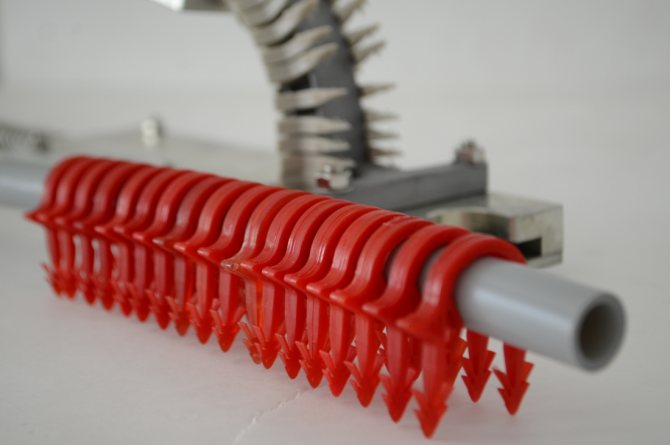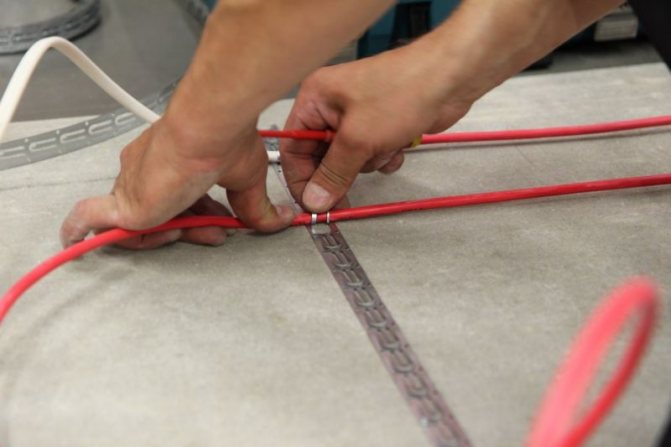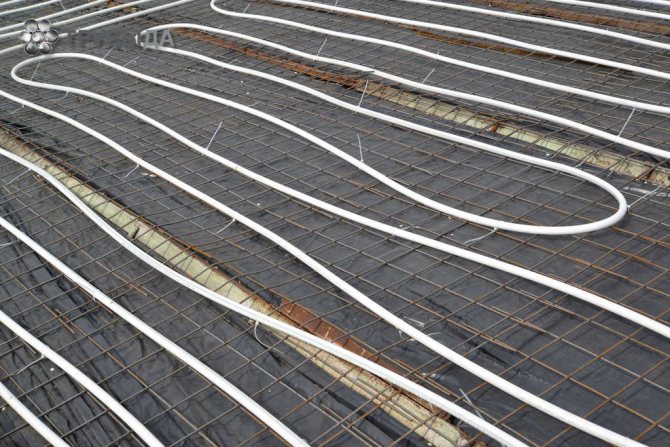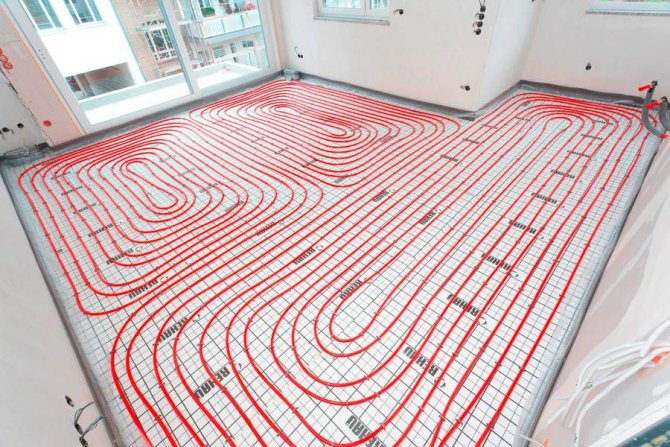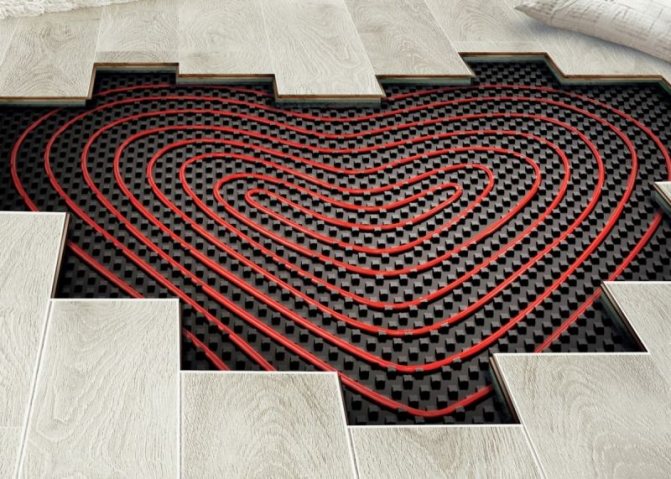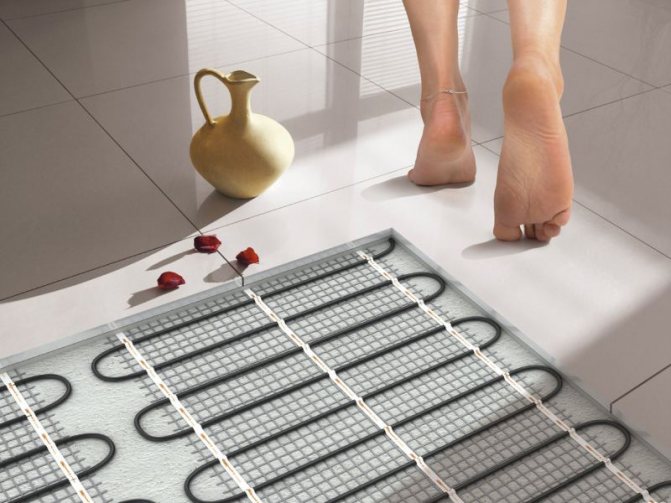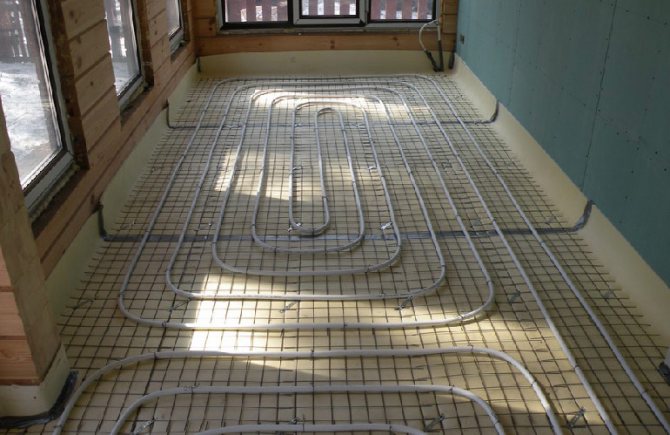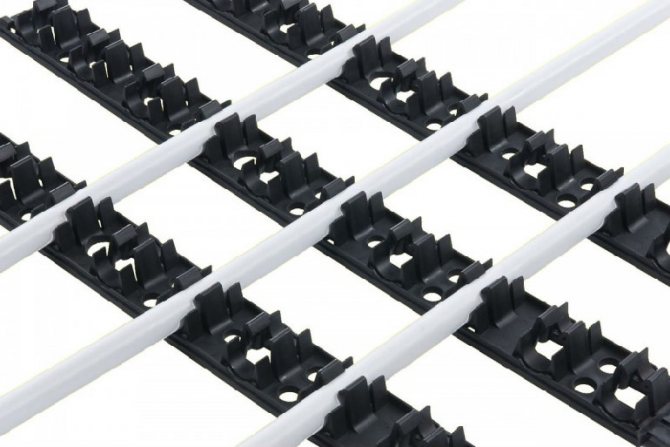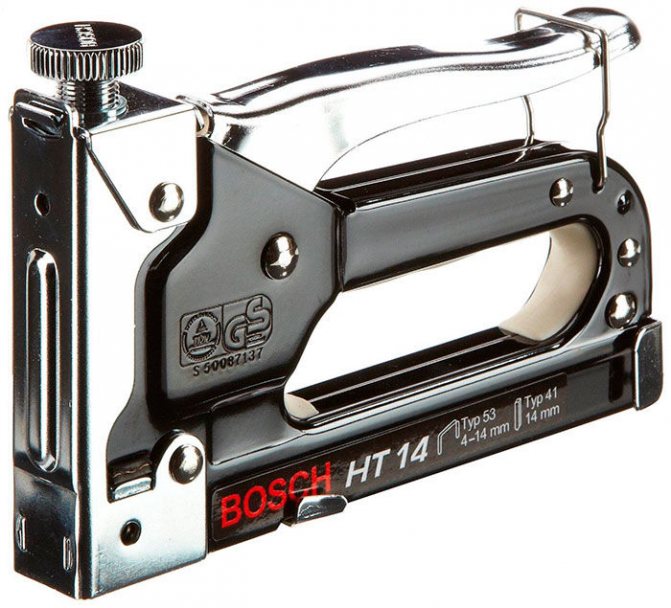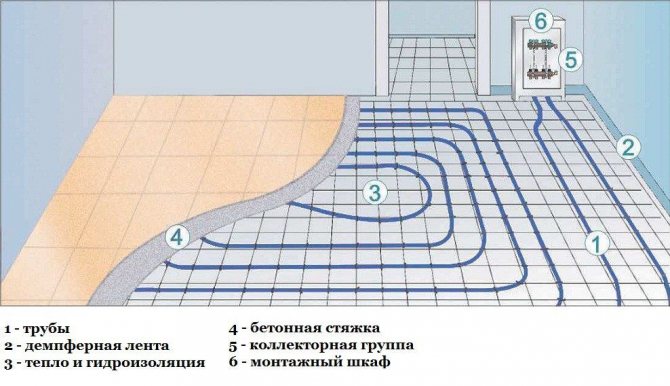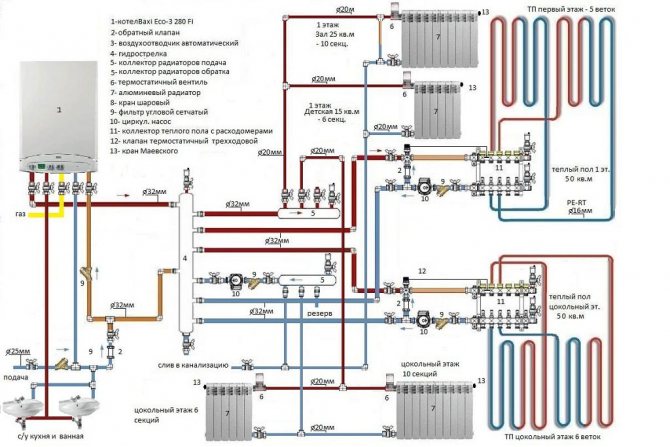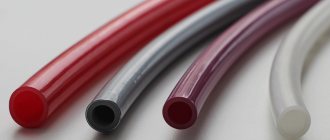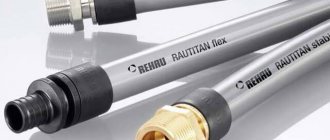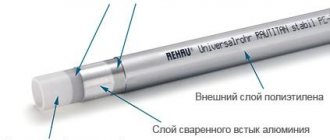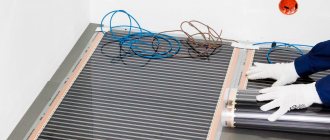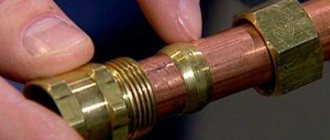Today, the presence of a warm floor in a house or apartment is far from a luxury and not uncommon. Any owner of a private house or apartment can easily buy and install it, both independently and with the help of specialists (depending on the type and method of fixing the underfloor heating pipes). Most often, such floors are installed by people not for their comfort, but for children. In addition, the heat from the floor is evenly distributed over the entire area of the room in which it is installed. Now in the markets and in specialized stores, customers are presented with a wide range of various underfloor heating. Their differences are only in price and installation method.
Fastening the pipe to the reinforcement mesh

The pipe is not tightly attached to the mesh (distance of several centimeters), fixed with special clamps. The brackets are fastened one at a time at a distance of one and a half meters from each other, but when the pipe is bent by 90 degrees, the pipe is fixed with three brackets for more reliable fixation.
On our second channel, Andrey Elfimov told about a useful life hack for attaching a floor heating pipe to a reinforcing mesh:
Benefits: All elements of this method of pipe fastening are available in specialized stores or on the market. A simple and reliable way.
Disadvantages: Time consuming installation process. The possibility of damage to the pipe is not excluded, since pipes made of metal-plastic are often used.
What fasteners for underfloor heating to choose?
The choice depends solely on personal preference. Here you need to weigh all the pros and cons, and then decide on the most optimal option. If it is difficult to do this on your own, you can always contact the specialists in your field:
- using polystyrene plates, you can install the system as quickly as possible;
- metal mesh is chosen by those who want to save money;
- anchor shackles are an option for those who are not afraid of difficulties and want only the best option.
When deciding on the type of fastener, it is necessary to build on personal financial capabilities, the peculiarities of the system operation, as well as the time that is available for installation.


It is worth considering any risks in the operation of the system, which can lead to the destruction of the work done.
Using brackets for underfloor heating, you will not have to worry about the fact that under high pressure or under mechanical stress, the pipes will come off the place, which will cause the entire system to be repaired.
- Similar posts
- What are the advantages of Thermo underfloor heating?
- What are the advantages of a warm floor made of metal-plastic?
- Features of underfloor heating Fenix
- How to install cable underfloor heating?
- What is a mobile floor heating?
- How to make a solution for underfloor heating screed?
Fastening the pipe to the mounting rails


This method is no more complicated than the previous one. The pipes are fixed with special clamps that hold tightly and protect the system from mechanical damage. Also, such systems are easy to install on the wall, the only problematic is that it is quite difficult to find such a heating system in specialized stores. In addition, the complexity arises in the preliminary markup. But in general, this method is very convenient and practical.
Underfloor heating types
Today there are three main types of underfloor heating systems:
- water;
- electric;
- infrared.
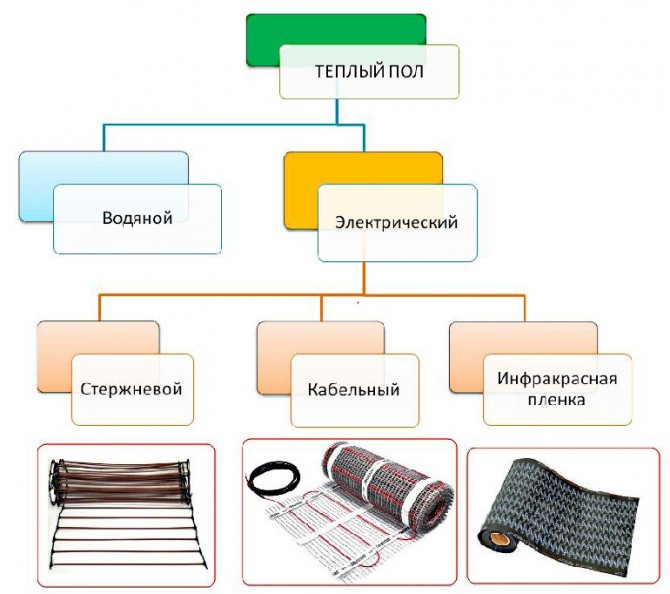

A water-heated floor operates on the basis of water pipes, which are laid directly under the finished floor covering.The source of the coolant is hot water from the heating system (less often - from a separate heating device - a boiler and a boiler). For the installation and connection of pipes, metal-plastic and plastic pipes are used, which are connected to the heating outlet pipeline.
Electric floor heating is based on the so-called. heating cable. Passing current through itself, the wire converts its energy into heat due to the high resistivity of the conductive core. Any cable is not suitable for arranging an electric underfloor heating - you need a special wire with a core of the required thickness, as well as with good insulation.
Infrared floor heating is the rarest variety. It is installed on the basis of special roll films, in which special heating elements are built. Under the influence of the current strength, they produce infrared radiation, forming heat.
Attention! The most popular and widespread type of underfloor heating system is water. It differs from other varieties in maximum power and heating temperature range and ease of use. With the help of devices for automation of work - temperature sensors, thermostats - you can flexibly set the temperature mode of the system.
Further we will talk specifically about the water type of underfloor heating, which is preferred most often, because it is much easier to connect pipes to an existing heating system in a house or apartment.
We recommend that you familiarize yourself with: The use of a corrugated stainless steel pipe for a heating system
Fixed polystyrene foam boards
Option 1
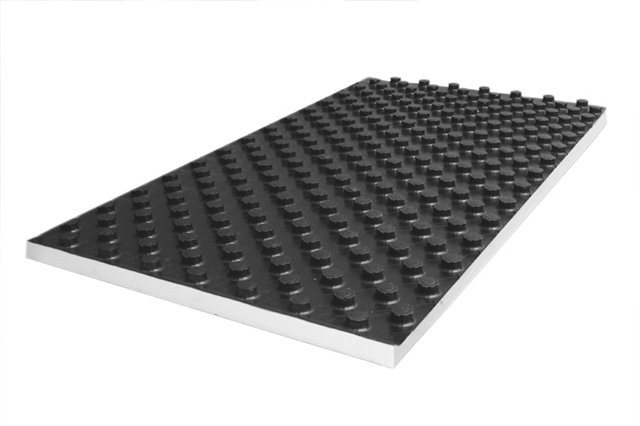

A very creative way to install pipes. Since with the help of volumetric protrusions on the coating, the pipes can be laid in any pattern as soon as you want. Despite the small distance between the protrusions, many people think that this is what will fix the pipe, but this is far from the case. For fixing, special clips are also used, which guarantee the reliability of a strong fastening of the pipe.
Benefits: The pipe is protected from mechanical damage by special lugs. Such a system can be freely purchased both on the market and in a specialized store.
Disadvantages: Quite a high price for all components. Additional elements must be used to fix the pipe.
Option 2


This installation method is very similar to the previous one, but there are significant differences. There are special protrusions on the cover that firmly fix the pipe without any additional equipment. The pipe can be fixed in a very simple way: by gently pressing the pipe between these protrusions.
Benefits: This method of fastening the pipe is considered very convenient and reliable. The slab is not damaged when moving across the floor. An excellent combination of functionality, quality and price.
Disadvantages: The cost is much higher than the previous examples. Such a copy is quite difficult to find in markets and in specialized stores.
How is a warm water floor and how it works
To begin with, let's talk about the general arrangement of a water-heated floor. It is a system of pipes laid in the floor structure through which the coolant flows. The floor heats up due to the fact that the coolant gives off its heat.
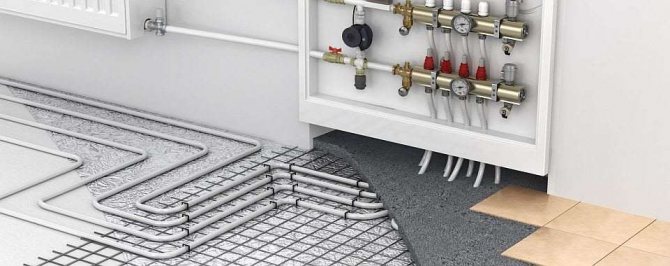

What is required for a water heated floor
The coolant is either water or an antifreeze liquid. In most cases, water is used. The boiler heats it up. Sometimes in new multi-storey buildings there are special risers for connecting a water-heated floor. But this is more the exception than the rule. Therefore, we will talk about a floor heating system powered by a boiler.
Purpose of the main nodes
The underfloor heating pipes are looped and connected to the boiler through a special mixing unit. One end for the feed, the other for the return.The task of the mixing unit is to lower the temperature of the heating medium, which at the outlet of the boiler can reach 90 ° C and higher. Typically, underfloor heating is a secondary heating system, and radiators provide the main heat. Here hot water is supplied to them. In the pipes of the underfloor heating, the maximum heat carrier can be supplied with a temperature of 35-45 ° C (depending on the type of floor covering). Otherwise it will be too hot and uncomfortable.


Equipment for a water-heated floor: general scheme
It is difficult to do without a manifold distribution system. This equipment serves to equalize the temperature of the coolant in different circuits (pipe loops) of a water-heated floor. The fact is that the length of the underfloor heating pipe is limited. It depends on the power of the boiler, the performance of the pump, the section of the pipe itself, the material from which it is made.


An example of the layout of the contours of a warm water floor
Usually one circuit is about 50 meters of pipe. Maybe more and less. The minimum in the presence of a collector group is not limited, and the maximum is about 70 meters. Moreover, even in a small room, you have to lay more than one loop. And the loops are usually of different lengths. If you supply water with the same temperature to loops of different lengths, the long outlet will have very cold water, and the short one will be quite warm. This leads to different heating of the floor. That is, some piece can be hot, and some noticeably cold. The collector unit is also engaged in the equalization of temperatures.
He has one more use. It makes it possible to set different floor temperatures in different rooms. For example, you can make the bathroom warmer and the living room cooler. Or whatever you like.
List of required components
The diagram shows not all the nodes and the necessary materials that will be required for the installation of a warm water floor. Below is a more complete list with short notes. We will proceed from the fact that all preliminary work has been carried out, floor insulation is already present or is not necessary. We will also not count concrete or sand-cement mixture. Their thickness and the required amount are calculated separately. We also do not take into account how exactly the water will be heated, as well as the pipes of the eyeliner. With all these "buts" in mind, here's what you need for a warm water floor:
- Pipes. They will be required in large quantities. They must be flexible, reliable, capable of withstanding high pressure and temperature for a long time.
- Pipe fastening system. They are laid according to a certain scheme with a certain (calculated) step. So that they do not move when pouring concrete, they must be fixed.
- Mixing and pumping unit. Serves to obtain water of a given temperature, and the pump - to overcome the hydraulic resistance of the system.

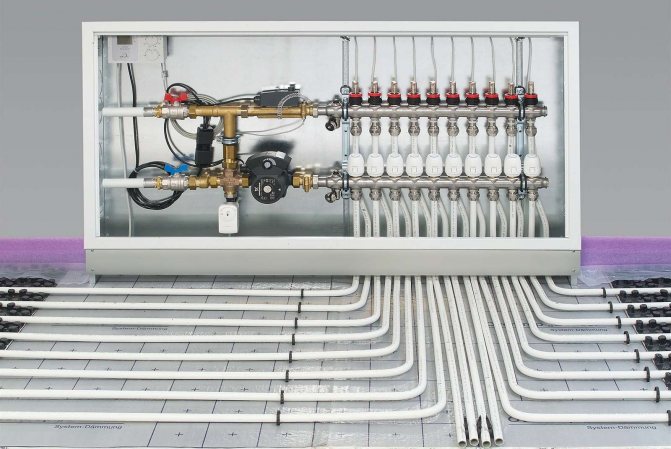
Components for a warm water floor: what will be needed for the installation of the system - Collector system. For the "distribution and collection" of the coolant along the contours of the warm floor. Can be equipped with flow meters or thermostatic valves. They serve to regulate the temperature in each circuit.
- Mixing and manifold units are installed in a manifold cabinet. This is a metal box in which all the mechanics are packed.
Actually, this is the entire list. But you will need some more fittings and other consumables. It is difficult to list them, since everything depends on the system and the components used.
Tacker fastening


The pipe is fastened using a special device - a tacker, which holds about 120 clamps. The pipe is fixed according to the marking with the help of this device. The process takes a small amount of time, but despite the speed of fixing the pipe, the fixing is very reliable.The only drawback of this method is the cost of the equipment - 230 euros. Finding him in a domestic special store is very difficult. This mounting method is suitable for installers and trained professionals in the field.
Which way do we use?
For a long time, we have used the method of attaching a pipe to a reinforcing mesh. There were many reasons for this: price, lack of other offers and expensive delivery on order. Now we are bringing in anchor shackles and fixing the pipes with a tacker. This significantly speeds up the installation process. Difficulties usually arise when pipelines run at close range. The tucker does not pass between the pipes and our tucker often makes false positives. It is not yet known whether this is a feature of all tuckers or only ours.


